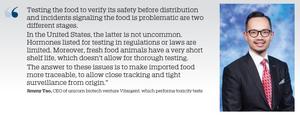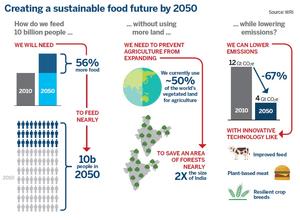Overdependence on food imports leaves Hong Kong vulnerable to supply disruptions like COVID-19. Food safety regulations need updating. Biological testing is more reliable than random sampling of incoming food products. Industrial farming embeds toxicity in the food chain. Citizens have a low-exercise, high-stress, dining-out lifestyle, which can trigger chronic diseases. Wang Yuke reports.
In 2017, over 90 percent of food in Hong Kong was imported. This makes Hong Kong vulnerable to food safety and security risks. A purposeful Hong Kong-specific legal framework is needed to ensure safe food production at source, says Leung Ka-sing, adviser to the Food Safety and Technology Research Centre, the Hong Kong Polytechnic University.
To combat food-borne diseases and poisoning, proactive engagement with the food-supply chain is vital, Leung believes. “We ought to communicate closely with the source countries/regions, from farming practices, through the supply logistics, to the market.” Leung expects food supply to be traceable for integrity, and to enable timely product recall. So far, the monitoring and management of food safety in the city have been passive, Leung says.
Jimmy Tao, CEO of biotech venture Vitargent, which performs toxicity tests, agrees. “The random inspection and import document checking at the customs are nothing more than routine,” says Tao. “That the samplings pass does not mean they are 100 percent safe. Whether the product is harmful or not can only be confirmed by biological testing.”

Outdated laws
Tao feels the existing food-safety laws and regulations are a patchwork borrowed from other countries. “We do not have our own food-safety laws specifically designed for Hong Kong,” says Tao. “It’s a lame effort.” Tao cites the case of growth hormones in livestock feed: “There’s a crop of newly minted hormones in husbandry not on the list of substances required to be tested.”
Tao concedes that regulatory updates fall behind the pace of new substances being added to food products. But the government must proactively revisit its old laws, he says, and more importantly, “use biological toxicity testing to screen out food products that pose even a slight health risk to consumers”. Irrespective of the legal frameworks, biological toxicity testing confirms product safety for humans.
More health dollars
The government has increased its recurrent expenditure on healthcare by an average of 7 percent over the past decade. In the 2018-19 budget, the government said that expenditure on public healthcare services would increase by 13.3 percent to HK$71.2 billion ($9.19 billion). An additional annual funding of HK$100 million is allocated to promote healthy lifestyles, to reduce cardiovascular diseases and cancers, among others.
In May 2018, the government launched “Towards 2025: Strategy and Action Plan to Prevent and Control Non-communicable Diseases in Hong Kong”. Among the nine local targets to be met by 2025 is a 30 percent reduction in daily intake of salt/sodium, to reduce high blood pressure, diabetes, and obesity.
Collaborative action
Singapore is also heavily dependent on imported food. It established the Singapore Food Agency in April 2019, as a statutory board under the Ministry of Sustainability and the Environment.
The SFA integrates the food-related functions of the former Agri-Food and Veterinary Authority, National Environment Agency, and the Health Sciences Authority. The National Centre of Food Sciences acts as the regulatory food analytical laboratory of the SFA, to monitor food-borne diseases, poisoning, spoilage organisms, harmful chemicals, toxins, and economic fraud.
The SFA formulated strategies for a safe-food supply — diversify sources, grow local, grow overseas, and control farm-to-fork integrity. This intervention looks to enhance the food industry capacity, tap new technologies to raise productivity, fund applied research, and catalyze industry transformation. The SFA set a benchmark of 30 percent local food production by 2030.
Intensive farming folly
Urbanization and rising affluence drive the dietary preference for meat. The per-capita beef consumption in Hong Kong rose from 6.42 kilograms to 25.82 kg between 1961 and 2012, according to the Food and Agriculture Organization of the United Nations. Pork and poultry consumption in the city soared from 18.51 kg to 67.11 kg during the period.
The increasing demand for affordable meat led to intensive farming where poultry and other food animals are confined within high-density space, allowed little movement, and given inputs of chemically treated feed to accelerate growth. Diseases arising from the waste contamination are treated with antibiotics.
The challenge for food production to scale rapidly to feed the world’s growing population intensifies. The consequential toxicity in the human food chain is tolerated, as people do not die immediately, but slowly and painfully, from degenerating organs or cancers. Governments do not have to deal with politically explosive mass starvation. Public healthcare deals with the victims.
Ilan Goldberg, director of campaigns for SAFE, a food-animal rights advocate in New Zealand, observes that “you can’t have cheap meat without intensive farming, and you can’t have intensive farming without animals suffering.” Governments are not too conscience-stricken about that. The urban middle-class only sees meat at affordable prices in shiny plastic wrap.
Self-inflicted hazards
Unintended consequences follow the intensive farming of animals and food crops. Pesticides that boost the productivity of cereals and fruit have killed bees and a whole spectrum of insects and birds, upsetting the natural ecology of the planet. Chemical fertilizer run-off through ground water releases nitrous oxide gas and ammonia. All that adds to climate change and global warming.
As agricultural soil degrades from mismanagement, “we push further into wildlife areas,” says Dirk Pfeiffer, professor of veterinary medicine at City University of Hong Kong. This encroachment into wildlife habitats forces proximity of livestock with bats, rats, and other virus and bacteria carriers, whose immune systems protect them. But domestic cattle, goats, and poultry can be infected. When human handlers are infected, social spread explodes.
The cross-over of viruses from wildlife to humans leads to pandemics. COVID-19 shows how fragile the ecosystem is.
Embedded toxins in food
Intensive farming and the cocktail of growth hormones and antibiotics in feed are a huge health risk tolerated in industrial agriculture. These toxic chemicals are harmful to humans. They are normalized in the human food chain for being efficient and low-cost. Private companies with global supply logistics dominate the food industry with the nod from governments.
Government-subsidized agricultural systems in the United States, France and Japan make affordable products easily available through supermarkets. “Concentrated animal feed operation” is the US term for intensive farming which facilitates predictable and profitable returns for food corporations.
Poor hygiene in industrial agriculture incubates and spreads bacteria and viruses. Erik Millstone, emeritus professor of science policy at Sussex University, notes that in the UK, European Union, and on the Chinese mainland, “there is enthusiasm for intensive units for pigs and poultry.”
![]()
Antibiotics abuse
Millstone saw sacks of pig feed in some farms with no labels. He learnt that farmers chose the brands that speedily fatten the pigs. “The brands of choice probably have the highest level of antibiotics in them,” Millstone says.
Pfeiffer notes that a majority of farmers use antibiotics not to treat diseases, but as a preventive measure. He says that 60 percent of all antimicrobials used globally go into the production of food animals. Pfeiffer finds it “critically dangerous” that local farmers drive across the border to buy cheap antibiotics. The abuse of antibiotics in animal feed increases antibiotic resistance that can defeat human antibiotic treatment.
Pfeiffer investigated samples of meat from local wet markets and supermarkets. He found a high proportion of residual bacteria on meat was resistant to antibiotics. Children and the elderly with chronic diseases are particularly at risk. Martin Wong, professor of public health at the Chinese University of Hong Kong, urges consumers to wash and cook raw meat thoroughly to eradicate harmful residues. Wong encourages more public education on food contamination.
Reduce dining out?
A PolyU study in 2016 showed 27.3 percent of the 401 respondents, aged between 15 and 59, ate out every day, and 59.3 percent ate out at least four days a week. Furthermore, local consumers ingest higher levels than the WHO-recommended limits on salt and sugar associated with chronic diseases. The Centre for Food Safety records 720 to 1,020 people annually affected by food poisoning. There were 158 food-borne outbreaks affecting 641 people in 2018.
The Hong Kong Population Health Survey of 2014-15 found half of residents aged 15-84 were overweight or obese, with 0.6 percent aged 15 or above having chronic kidney diseases. The survey found 4.7 percent had “diabesity,” the combination of mainly Type 2 diabetes with obesity. Diabetes and hypertension are the key drivers of kidney diseases. Wong attributes these metabolic disorders to unhealthy lifestyles.
“The metabolic syndrome is a contributing factor of cancer, cardiovascular diseases and stroke,” Wong cautions. He points to the local fondness for eating out, lack of exercise, work and life stress, alcohol and smoking habits as primary lifestyle causes of the metabolic syndrome.
The World Cancer Research Fund found correlations between dietary choices and types of cancer: Red meat increases the risk of colorectal cancer; preserved and salted food increases the risk of stomach cancer; aflatoxin-contaminated food increases the risk of liver cancer. Cancers in Hong Kong hit a historic high of 31,468 cases in 2016.
Exhausted soils
Saturating agriculture with chemical fertilizers acidifies and salinizes the soil and frees carbon in the earth, leading to air and water pollution, on top of rendering the abused soils unsuitable for plant growth. The hacking down of forests and hills erodes the fertile top soils and contributes to flooding.
A third of the world’s agricultural soils is exhausted. Almost 95 percent of the food we consume comes from the soil. Healthy soil stores clean water, traps carbon, yields nutrients for plant growth, and acts as a buffer against pollution. The 2015 Status of the World’s Soil Resources report of the FAO confirmed this tragic loss. The FAO called for “transformative change in our food systems”.
Soils take centuries to form from rock decomposition. They are rich in minerals and nutrients. Healthy soils feed plants with nutrients that sustain human life.
The return to natural farming and clean soil needs governments and corporations to be fully accountable.
Contact the writer at jenny@chinadailyhk.com




